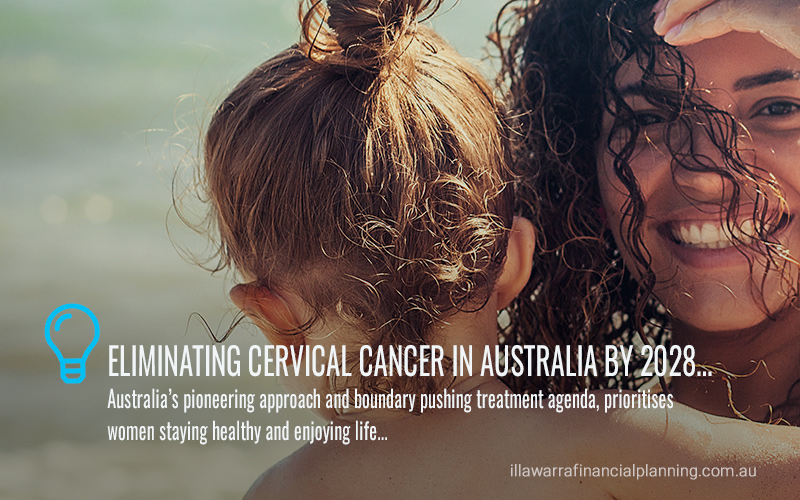New vaccinations and screening techniques could see cervical cancer eliminated from Australia by 2028 [1].
We look at our nation’s boundary-pushing treatment agenda and tips for women to stay safe.
Cervical cancer is the fourth most common cancer amongst women around the world - there were 570,000 new cases in 2018 alone according to the World Health Organisation [2], with 933 of those affecting women in Australia, Cancer Australia reports [3].
However, times may be about to change.
Australia has been at the cutting edge of cervical cancer prevention for decades, and recent studies indicate that the disease could become a rarity in this country by 2020 and eliminated by 2028 [1]. Preventative vaccines and new testing techniques are proving an effective combination.
Australia’s pioneering approach
Australia’s great record in tackling cervical cancer is largely down to focusing research and resources on the human papillomavirus (HPV infection).
This infection is the cause of 99.7% of cervical cancer carcinoma and is present in around 90% of adults [4]. However, it was not being tested for in traditional cervical cancer Pap smear tests.
The country needed a new approach to prevent and detect HPV. This came about as a two-step process:
- HPV Vaccinations In 2007, HPV vaccinations were made available to children all over Australia through school-based programs. The aim was to immunise the young population before they could be exposed to the potentially harmful virus. Over the years, vaccinations became more and more efficient, and today’s vaccine will guard against strains of HPV responsible for over 93% of cervical cancers.
- New cervical screening test The focus on HPV was reflected in improved screening techniques, which began in Australia in 2017. The new cervical screening test looks for HPV, rather than the precancerous abnormal cells that the old Pap smear would detect the Cancer Council reports [5]. By detecting HPV, doctors are able to help prevent cervical cancer before it takes hold by providing the right treatment to eradicate the virus.
Key Facts
- The new cervical screening test is expected to reduce cervical cancer rates and deaths by 20% according to the Cancer Council [5].
- The screening program has been shown to be 100% effective at preventing cervical cancer for women who take full part in the program the Cervical Cancer: The Australian Program report shows [6].
How to be proactive against cervical cancer
According to the Australian Institute of Health and Welfare:
- Between January 2017 and June 2017, 7 women out of every 1,000 screened had a high-grade abnormality. Screening gave them an opportunity for treatment before possible progression to cancer [7].
- Between January 2016 and June 2017 54%–56% of women aged 20–69 participated in cervical screening [7].
While cervical cancer cases in Australia are predicted to decline over the years to come, success relies on women taking a proactive approach to their health through preventative actions.
Here are a few tips to follow to keep yourself safe:
- Get vaccinated and make sure your children are too. You can find out more information about how and where to do this from the Department of Health website.
- Attend your screenings. If you are between 25 and 74 you should receive the new cervical screening test every five years. If the last test you had was the original Pap smear, you should go for the new cervical screening test two years from the date of your last test. For more information on screening, visit the government’s Cancer Screening Site.
- Be aware of changes. Don’t wait for your next test if you experience any unusual changes to your body or your period. Visit your GP and explain your symptoms.
Every plan A needs a plan B because plans don’t always go to plan...
Why not booking a time to start planning. Your future you deserves it from you. Either book a coffee meeting or call us to arrange an appointment on 02 4229 8533.
[1] Hall M, Math M, Simmons K, et al. 2018, The projected timeframe until cervical cancer elimination in Australia: a modelling study, Lancet Public Health Open Access, viewed October 2019 https://www.thelancet.com/journals/lanpub/article/PIIS2468-2667(18)30183-X/fulltext
[2] World Health Organisation, 2018, Cervical Cancer, viewed October 2019 https://www.who.int/cancer/prevention/diagnosis-screening/cervical-cancer/en/
[3] Australian Government, Cancer Australia, 13 September 2019, Cancer incidence, viewed October 2019 https://ncci.canceraustralia.gov.au/diagnosis/cancer-incidence/cancer-incidence
[4] Muñoz N, Bosch FX, de Sanjosé S, Herrero R, et al. Epidemiologic classification of human papillomavirus types associated with cervical cancer. N Engl J Med. 2003; 348(6):518–27. https://www.nejm.org/doi/full/10.1056/NEJMoa021641
[5] Cancer Council, 16 April 2019, Australia set to eliminate cervical cancer by 2035, viewed January 2020 https://www.cancer.org.au/news/media-releases/australia-set-to-eliminate-cervical-cancer-by-2035.html
[6] Dr Cummins, J, 2019 Cervical Cancer, The Australian Program, viewed October 2019 https://www.scor.com/sites/default/files/scor_inform_cervicalcancer_en.pdf
[7] Australian Institute of Health and Welfare, 6 May 2019, Cervical Screening in Australia 2019, viewed October 2019 https://www.aihw.gov.au/reports/cancer-screening/cervical-screening-in-australia-2019/contents/summary
Disclaimer: The Health and Medical information is general in information only and is not a substitute for advice from a qualifies medical or other Health Professional. It is not intended to diagnose, treat, cure or prevent any disease. Always consult your General Practitioner or Medical Specialist.
General Disclaimer: This article contains information that is general in nature. It does not take into account the objectives, financial situation or needs of any particular person. You need to consider your financial situation and needs before making any decisions based on this information. Please seek personal financial advice prior to acting on this information.

